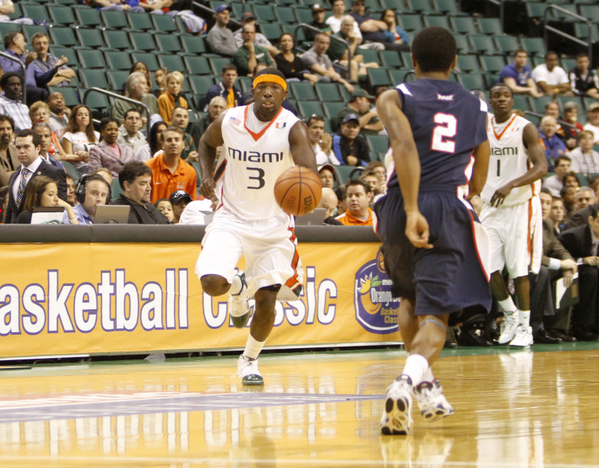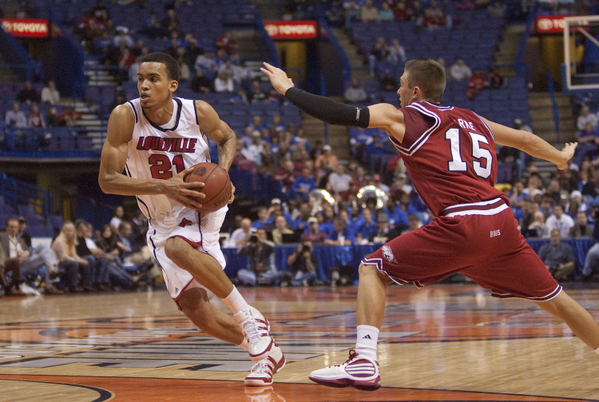Ball Reversal: 24 Hours of Hoops Marathon
Posted by zhayes9 on November 15th, 2010Zach Hayes is an editor, contributor and bracketologist at Rush the Court.
Even though nearly every team has at least one game under their belt this season, Tuesday’s 24-hour hoops marathon is the unofficial day college basketball gets underway. ESPN did a fantastic job scheduling games that are meaningful, including a battle of top ten teams in Gainesville, reigning national runner-up Butler helping to open Louisville’s new arena and a matchup of two of the West’s best. In order for these teams to pick up resume-building wins at this early stage, here is one facet of the game they absolutely must control to give themselves the best chance at victory:
Miami at Memphis (12 AM ET)
How Memphis wins: Win the turnover battle. The Canes ranked a paltry 206th in the nation in turnover percentage a year ago and ranked just 195th in the country in forcing turnovers at the other end. Although departed senior Dwayne Collins was the biggest offender, starting guards Durand Scott and Malcolm Grant had a major hand in piling up the giveaways. If the Tigers unleash their speedy new backcourt, led by freshmen Joe Jackson, Will Barton and Chris Crawford, turning Miami over and taking care of the basketball on their end should lead to a sufficient number of possessions to take advantage of a Canes defense that was equally mediocre in 2010-11.
How Miami wins: Control the offensive glass. Memphis struggled mightily preventing their opponents from gathering offensive rebounds last season, ranking 305th in the nation in offensive rebounding percentage surrendered. The Tigers allowed opponents to snatch a second chance opportunity on 36.4% of their possessions compared to the Division I average of 32.7%. Trotting out 6’11 Angel Garcia for more than 12 games this season should aid the cause, but if the Hurricanes can use their glut inside (most notably 6’10 behemoth Reggie Johnson who collected eight boards in Miami’s opening win over Jacksonville) for extra kick-out threes to Malcolm Grant (41% last year), Frank Haith’s squad may have the firepower to upset a Memphis team still trying to figure out rotations.
St. John’s at St. Mary’s (2 AM ET)
How St. John’s wins: Feed the big fellas. Remember Omar Samhan? The fun-loving, quotable, double-double machine that crept into the lexicon of every college basketball fan last March? Samhan and his 21/11 average graduated as a senior last year, leaving a gaping hole in the middle of the Gaels frontcourt. Samhan was as important to his squad as any player in the nation, playing over 80% his teams’ minutes and placing in the top 60 in the nation in numbers of possessions used, percentage of shots taken, offensive and defensive rebounding percentage and block percentage. The Gaels will try to plug the gap in the middle with Rob Jones, Clint Steindl, Kenton Walker and Mitchell Young, but a Big East-level talented bunch like the Johnnies should feed the paint over and over again. Justin Brownlee, Justin Burrell, Sean Evans and freshman Dwayne Polee all stand over 6’7 and leading scorer D.J. Kennedy is 6’6. It’s not like the Gaels were that proficient in defending two-point buckets with Samhan, anyway, ranking 116th in the country.
How St. Mary’s wins: Stick with your bread and butter: three-point shooting. St. John’s might be returning nearly all of their scoring from a year ago, but they also return the same core that allowed opponents to sink 36% of their threes, ranking 264th in the nation. This is splendid news for Randy Bennett and a Gaels team that averaged a stellar 41% from the same range a year ago and returns their two most accurate gunners — Mickey McConnell (51%, not a typo) and Matthew Dellavedova (40%). While St. John’s did a respectable job at guarding the paint in 2010-11, their perimeter defense is suspect.
Virginia Tech at Kansas State (4 PM ET)
How Virginia Tech wins: Let Malcolm Delaney draw fouls. Few players in the nation were as proficient as Delaney at finding the charity stripe last season. The all-ACC candidate ranked 32nd in the nation in fouls drawn per 40 minutes and in the last two seasons his free throw percentages are 87% and 84%. Delaney gets to the line plenty and takes advantages of those opportunities. His opponent on Tuesday, Kansas State, followed Delaney’s lead by getting to the line fewer than only three teams last season, but they also ranked near the dregs of Division I at allowing opponent free throw opportunities. This plays right into the hands of Delaney, especially when one considers the player that fouled with the lowest frequency is departed senior guard Denis Clemente. If Seth Greenberg can isolate Delaney 1-on-1 with Pullen, Tech may coax Kansas State’s All-American guard into foul trouble and leave Manhattan with a stunning victory in the process.
How Kansas State wins: Utilize their superior frontcourt depth. The story of this game isn’t necessarily the Delaney-Pullen duel in the backcourt, but how Virginia Tech can manage to keep this game competitive in a tough road environment with so little depth among the trees. Without J.T. Thompson or Allan Chaney to man the paint, it’s up to 6’8 Victor Davilla, 6’7 freshman Jarell Eddie and 6’6 wing Terrell Bell to contain the Wildcats assembly line of big men. Kansas State, meanwhile, can rotate Curtis Kelly, Jamar Samuels, Freddy Asprilla and Wally Judge in a fearsome foursome against the over-matched, outsized and likely fatigued Tech big men. Dominate the paint and Pullen may not even have to contribute too much scoring-wise. What could help Tech is Curtis Kelly’s appearance in Frank Martin’s doghouse at the end of the bench last Friday. We’ll see if the UConn transfer suits up for this one.
Ohio State at Florida (6 PM ET)
How Ohio State wins: Make Florida hit more outside shots. One thing we know about Florida: nobody on the roster is afraid to jack up a three. Although expected improvement from the likes of Kenny Boynton and Erving Walker are anticipated this season, Florida shot a paltry 31% from long range a season ago, ranking 280th in the country (worth noting that Dan Werner was their biggest offender at 26% and his eligibility has expired). Florida also shot just 32% from deep in their first game, so it’s possible the issue didn’t magically fix itself over the summer. Meanwhile, the Buckeyes were rather accurate shooting the three-ball in 2010-11, finishing at 39%, good for 17th overall. That charge was led by Jon Diebler (42%), David Lighty (38%) and William Buford (38%), three key players back for Thad Matta this season. If Ohio State shows greater discretion and accuracy from downtown on Tuesday compared to their opponent, a gigantic road win should be in order.
How Florida wins: Force Thad Matta to play William Buford at the point. Many, including myself, were bullish on Ohio State’s chances to reach the Final Four this season. The one caveat to that expectation was their lack of point guard play in the absence of do-everything NPOY Evan Turner. True freshman Aaron Craft has filled the void nicely against inferior competition thus far, totaling 17 assists and zero turnovers in the Buckeyes exhibition and opening victories. The O-Dome is a different animal than North Carolina A&T at Value City Arena, though, and if Erving Walker can apply enough defensive pressure to force Craft into turnovers and a spot on the bench, it will have a domino effect. Two-guard William Buford or swingman David Lighty then has to man the point, taking away Ohio State’s best mid-range shooter or wing defender and forcing either DeShaun Thomas or Dallas Lauderdale on the floor with Buford, Lighty, Diebler and Sullinger.
Butler at Louisville (8 PM ET)
How Butler wins: Limit turnovers and keep the game in the halfcourt. Rick Pitino is no dummy. He knows his team isn’t a vintage Louisville unit, a far cry from the team he coached to a #1 seed just two seasons ago. Pitino realizes his group will have to out-work and out-execute their opposition, especially against an opponent like Butler that sports equal, if not superior, overall talent. Expect Pitino’s patented full-court pressure to be unleashed in even more aggressive fashion than previous campaigns. While one may view Butler as an ultra-intelligent team, they ranked 90th in the country in turnover percentage in 2009-10. That’s a solid number, sure, but not overly spectacular. Still, the Bulldogs have a better overall team and should win this game unless they allow Louisville to make this a full-court, running game with tons of extra possessions. Keep the game in the halfcourt and the Bulldogs will escape with a Big East scalp.
How Louisville wins: Win the battle on the offensive boards. The Cardinals lost their top three scorers, their top recruit was deemed academically ineligible and their top transfer did not receive an immediate eligibility waiver, so the Cardinals enter 2010-11 with tempered expectations. One area, though, where they do return enough bodies to make an impact is on the glass. Louisville ranked a stellar 15th in the country in offensive rebounding percentage a season ago, grabbing a staggering 39% of available misses. A good chunk of that rebounding talent is back, too, including athletic 6’9 junior Terrence Jennings, 6’8 junior Jared Swopshire, 6’8 sophomore Rakeem Buckles and incoming freshman center Gorgui Dieng. Where Butler excels last season was preventing their opponent from garnering second chance opportunities, ranking an equally stellar 18th in the nation. Still, the Bulldogs did lose top-flight defensive rebounder Gordon Hayward and fellow frontcourt mate Matt Howard can be prone to foul difficulties against the type of athletic big men that Louisville trots out. If the Cardinals can give their guards second chances and ride the energy of opening their new arena, an upset may be in order.
San Diego State at Gonzaga (11 PM ET)
How San Diego State wins: Match Steven Gray with James Rahon. Rahon could end up being one of the top impact transfers in the nation. The former Santa Clara sharpshooter has a history with the Zags from his WCC days and could be the secret weapon for the Aztecs. Steve Fisher’s team made the NCAA Tournament last season, but had a glaring weakness: three-point shooting. San Diego State ranked 265th in the country in three point percentage at a meager 32%, a frontcourt-dominated team that simply did not pose a shooting threat from the perimeter, giving their talented forwards less room to operate inside. Enter Rahon, who shot 41% from deep as a freshman at Santa Clara and made 4 of 7 in his Aztec debut Saturday at Long Beach State. When Gray (or inside-outside threat Elias Harris) get hot for Gonzaga from deep, San Diego State has a weapon to match the Gonzaga marksman point-for-point that they simply did not possess a season ago.
How Gonzaga wins: Make the Aztec big men earn their points. Along with three-point efficiency, Steve Fisher’s team also had trouble making free throws. Only DePaul and Duquesne ranked lower than SDSU’s 62% from the line among non mid-major programs. The Aztecs boast a handful of very talented forwards from MWC first teamer Kawhi Leonard to Billy White to Malcolm Thomas, but their 73%, 63% and 53% from the line, respectively, do not exactly inspire confidence. It’s absolutely imperative that if White or Thomas is in easy scoring position that a Gonzaga player commits a quick foul. This could save Mark Few’s team precious points in what may be the closest game of the day.













































Maybe next year we can go through the QB controversy thing. The difference has been that Whipple has reined himself in for the last 6 quarters and actually run the ball consistently.